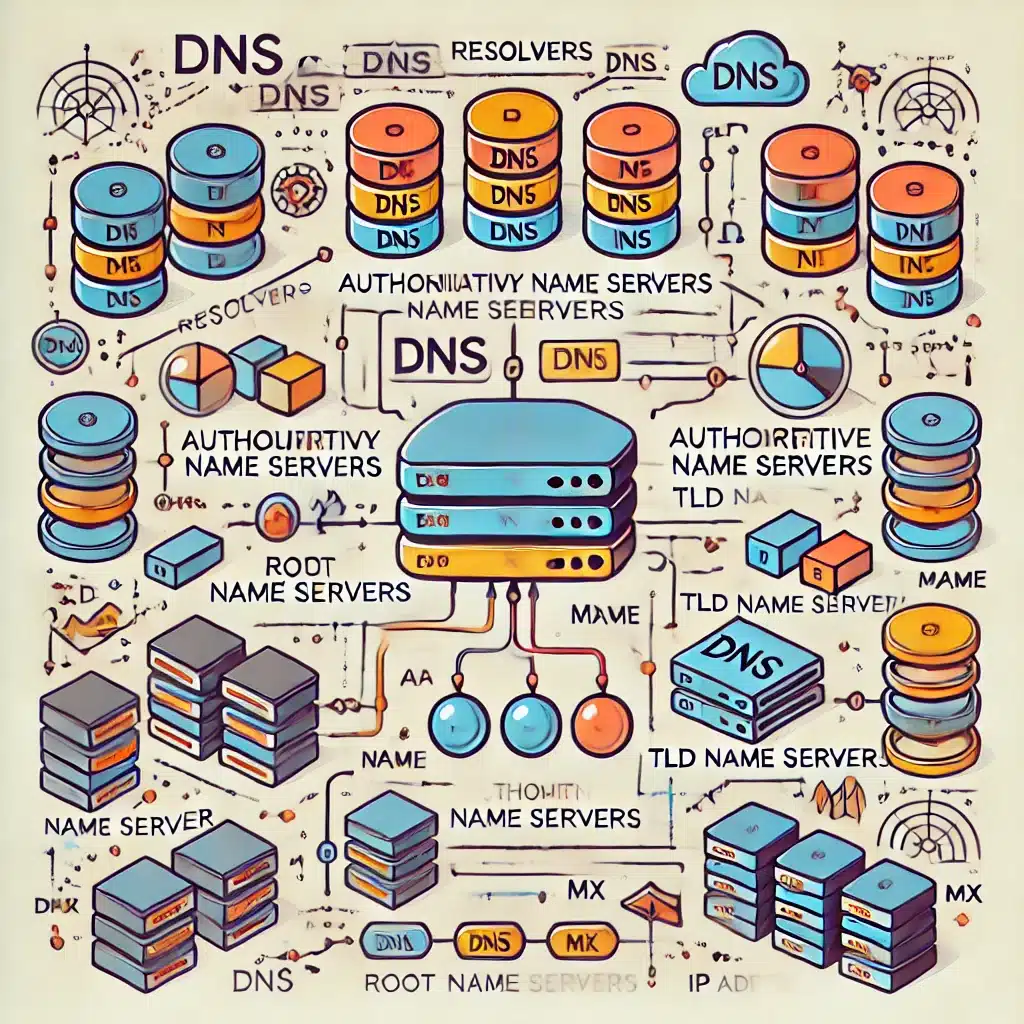Feeling like DNS is this big, scary monster you’ll never fully understand? Here’s some good news: you’re probably a lot closer to mastering it than you realize. In fact, there are really only six core concepts you need to have down pat. The rest? You can offload that from your mental RAM. Let’s walk through these essentials and show you how much you already know – and how little more you need to learn to handle 80% of your DNS needs with confidence.
You might want to scroll fast past the next table… its a bit intimidating.
A quick complete list of DNS Functionality and Descriptions
| # | DNS Functionality | Description |
|---|---|---|
| 1 | A Records | Map domain names to IPv4 addresses |
| 2 | AAAA Records | Map domain names to IPv6 addresses |
| 3 | CNAME Records | Create aliases for domain names |
| 4 | MX Records | Specify mail servers for handling email |
| 5 | TXT Records | Store arbitrary text strings, often used for domain verification |
| 6 | NS Records | Delegate a domain or subdomain to a set of name servers |
| 7 | SOA Record | Specify authoritative information about a DNS zone |
| 8 | PTR Records | Reverse DNS lookup, map IP addresses to domain names |
| 9 | SRV Records | Specify location of services (e.g., VoIP, IM) |
| 10 | CAA Records | Specify which Certificate Authorities can issue SSL/TLS certificates |
| 11 | DKIM Records | Email authentication method to detect forged sender addresses |
| 12 | SPF Records | Email authentication method to prevent email spoofing |
| 13 | DMARC Records | Email authentication, policy, and reporting protocol |
| 14 | NAPTR Records | Used for ENUM and SIP services |
| 15 | SSHFP Records | Store SSH public host key fingerprints |
| 16 | DS Records | Used in DNSSEC to secure delegation of subdomains |
| 17 | TLSA Records | Associate TLS/SSL certificate with domain name for DANE protocol |
| 18 | LOC Records | Specify geographical location of a domain |
| 19 | HINFO Records | Specify host hardware and operating system |
| 20 | RP Records | Specify a responsible person for a domain |
| 21 | AFSDB Records | Specify location of AFS cell database servers |
| 22 | Zone Transfers | Configure zone transfer settings between primary and secondary DNS servers |
| 23 | TTL | Set caching duration for DNS records |
| 24 | Reverse DNS Zones | Configure reverse lookup zones for IP to domain mapping |
| 25 | Subdomains | Create and manage subdomains |
| 26 | Wildcard DNS Records | Set up catch-all records for subdomains |
| 27 | DNS Forwarding | Configure DNS servers to forward queries to other DNS servers |
| 28 | DNSSEC | Enable and configure DNSSEC for securing DNS |
| 29 | GeoDNS | Set up location-based DNS responses |
| 30 | Round Robin DNS | Configure multiple A or AAAA records for load balancing |
| 31 | Dynamic DNS | Allow automatic updates of DNS records |
| 32 | DNS Aliases | Create alternative names for the same host |
| 33 | DNS Views | Configure different DNS responses based on the source of the query |
Intimidating, right? But here’s the secret: you don’t need all that. Let’s strip it down to the essentials:
| # | DNS Functionality | Description |
| 1 | A Records | Map domain names to IPv4 addresses |
| 2 | CNAME Records | Create aliases for domain names |
| 3 | MX Records | Specify mail servers for handling email |
| 4 | TXT Records | Store text strings, often used for domain verification |
| 5 | NS Records | Delegate a domain to name servers |
| 6 | TTL | Set caching duration for DNS records |
Look, I get it. DNS can seem like a labyrinth of cryptic records and arcane configurations. But here’s the dirty little secret: most devs are massively overcomplicating things. You don’t need to be a DNS guru to get shit done. In fact, understanding just six key concepts will cover about 80% of your DNS needs. Let’s break it down, shall we?
A Records: Your Domain’s Home Address
You’re launching a new website. Your hosting provider tells you your server’s IP address is 203.0.113.10. You’d set up an A record like this:
coolsite.com. IN A 203.0.113.1
In this case, 203.0.113.10 is the actual “house address” where your website lives on the internet. When someone types coolsite.com into their browser, this A record tells them to go to this specific IP address to find your website’s content.
Diving a bit deeper: A records can also be used for subdomain mapping. For instance, you could have separate A records for “blog.coolsite.com” and “shop.coolsite.com”, each pointing to different IP addresses. This allows for flexible hosting arrangements, like having your main site on one server and your blog on another.
CNAME: Your Domain’s Nickname Generator
You want both www.coolsite.com and coolsite.com to lead to the same place. You’d set up a CNAME record like: www.coolsite.com. IN CNAME coolsite.com.
Here, you’re saying that www.coolsite.com is just another name for coolsite.com. It’s like having a “doing business as” name – both lead to the same website, giving users flexibility in how they type your URL.
For the curious: CNAME records can be chained, but be careful – this can increase DNS lookup times. Also, the target of a CNAME must always be a domain name, never an IP address. This makes CNAMEs great for services that might change their IP addresses, as you only need to update the target domain’s A record.
MX Records: Directing Your Digital Mail
MX records are all about email. They tell the world which servers handle the email for your domain. Without these, your “[email protected]” address is about as useful as a chocolate teapot. Set them up right, and your email flows like a dream.
Example MX Records Usage
You’re using Google Workspace for email. You’d set up MX records like:
coolsite.com. IN MX 1 ASPMX.L.GOOGLE.COM.
coolsite.com. IN MX 5 ALT1.ASPMX.L.GOOGLE.COM.
These records are telling email servers that when someone sends an email to @coolsite.com, it should be delivered to Google’s email servers. The numbers (1 and 5) indicate priority – emails will try the first server before falling back to the second.
Going further: MX records have a priority value. You can set up multiple MX records with different priorities, creating a fallback system. If the primary mail server is down, the next one in line takes over. This adds redundancy to your email system, ensuring you never miss important messages.
TXT Records: The Swiss Army Knife of DNS
TXT records are the wild cards of DNS. Need to verify domain ownership? TXT record. Setting up email authentication? TXT record. They’re basically a place to stash any text-based information about your domain. Handy little buggers.
Example TXT Record
You need to verify your domain for Google Search Console. They ask you to add a TXT record like:
coolsite.com. IN TXT “google-site-verification=randomstringhere”
This record is like a secret handshake with Google. By adding this specific text to your domain’s DNS, you’re proving to Google that you have control over the domain, allowing you to use their Search Console tools for your site.
Digging deeper: TXT records are crucial for modern email security protocols like SPF, DKIM, and DMARC. These help prevent email spoofing and improve deliverability. TXT records can also be used for human-readable notes about the domain, though this is less common in practice.
NS Records: The Internet’s Yellow Pages
NS Record Example
NS (Name Server) records are crucial for the hierarchical structure of DNS. They tell the internet which servers are authoritative for your domain’s DNS information.
Example NS Record Usage:
You’re using Cloudflare for DNS. You’d set up NS records like:
coolsite.com. IN NS dana.ns.cloudflare.com.
coolsite.com. IN NS rick.ns.cloudflare.com.
By setting these NS records, you’re delegating responsibility for your domain’s DNS to Cloudflare’s name servers. It’s like telling the internet, ‘For information about coolsite.com, ask these Cloudflare servers.’
Going deeper: NS records are part of a larger system of delegation in DNS. When you change NS records, you’re changing who controls your domain’s DNS settings. This change needs to be reflected at your domain registrar to take full effect, which is why NS changes can take time to propagate fully across the internet.
TTL: The Expiry Date on Your DNS Cache
Time To Live (TTL) is how long DNS information is cached. Set it low, and changes propagate quickly but increase server load. Set it high, and you’ll wait longer for changes to take effect, but it’s easier on the servers. It’s all about finding that Goldilocks zone.
TTL Record Example
You’re planning to change your website’s IP address soon. You’d lower the TTL on your A record to 300 seconds (5 minutes):
coolsite.com. IN A 203.0.113.10 300
The 300 here means that DNS servers should only remember this information for 5 minutes before checking for updates. Before making significant DNS changes, it’s common practice to lower your TTL. This ensures that when you make the change, it propagates quickly across the internet. After the change has taken effect, you can increase the TTL back to a higher value for efficiency.
For the nerds: TTL is specified in seconds. A common strategy is to lower your TTL a day or two before making significant DNS changes. This ensures that when you make the change, it propagates quickly. After the change, you can increase the TTL back to a higher value for efficiency.
And there you have it, folks. Six simple concepts that’ll cover most of your DNS needs. Sure, there’s more to learn if you want to go deep – AAAA records for IPv6, DKIM for email authentication, DNSSEC for the paranoid – but honestly? You can probably offload that stuff from your brain for now.
Focus on these six, and you’ll handle 80% of your DNS tasks without breaking a sweat. When you do run into something more complex, you can always look it up. After all, isn’t that what we do for most of our jobs anyway?
So stop stressing about DNS and get back to building cool shit. That’s what we’re here for, right?


Leave a Reply